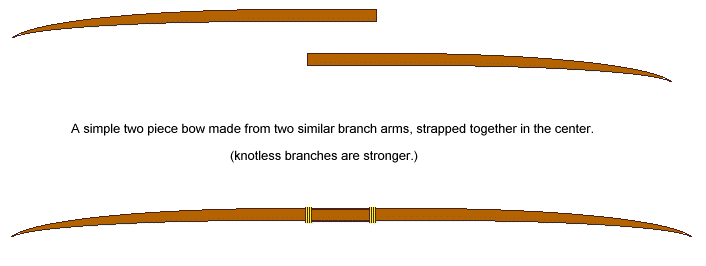
| |
 |
![]()
Quickie bows can be constructed in less than five minutes from a variety of materials. And can have the added advantage of being a takedown (taken apart again for easy transport). Take just two branches whose cut dimensions are about 40" long, 1/2" in diameter at one end, and 1/8" or so at the other. Taper the wider ends and lash the limbs together overlapping the tapered faces to thicken the handle. Straight knot-less branches yield safer more efficient limbs. Tilling the final product will give a more efficient and accurate bow. Steeply tapered branches will permit 59" to 70" bows, an effective length range. Less tapered branches must be longer in order to tiller properly. Short low tapered limbs are too round in the handle, and too nock heavy, so efficiency suffers.
 1
1
Another alternative is simple garden cane, or bamboo. With bundles of these you can raise the draw weight by increasing the number and also simulate tillering by using more cane mid bow, fewer canes towards the tip. Unlike a normal bow, each cane is strained independently. Strain on a single cane is the same whether bent alone or incorporated in a multi-cane bundle. Draw weight can be raised simply by adding canes. A good effective bow can be constructed from four 1/2" diameter, bamboo, garden supply bean poles. Good lengths are 23", 36", 54.5" and 70". Thick ends are staggered. Wrap every five inches. At 28" this bow will draw a staggering 58 lb. and cost practically nothing to make.

(Information provided from The Traditional Bowyers Bible).
Offered by Brian.